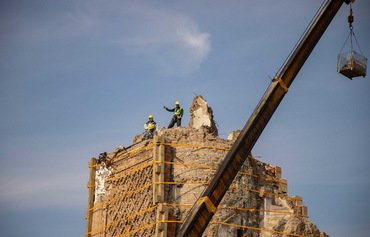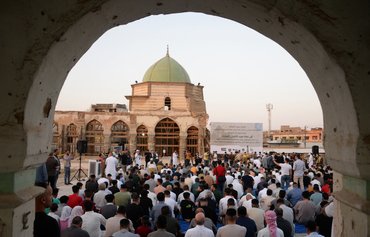A team of sculptors has been working to restore Mosul statues destroyed by the "Islamic State of Iraq and Syria" (ISIS) to their former glory.
After three months of hard work, the team last month managed to complete the first of its projects, a sculpture of a liquorice drink salesman, to replace one that had graced the city's al-Sawas roundabout until it was vandalized by ISIS.
Sculptor Omar al-Khaffaf said the team, which is headed by Nizar Abdul Latif and includes fellow sculptors Mohammed Nizar and Khaled al-Abadi, "is determined to restore the heritage" of the city.
"We started with 'the liquorice drink salesman', which is considered a folkloric landmark that adorned the city of Mosul before terrorists descended upon and destroyed it, and with it other historical sites," he told Diyaruna.
![Two sculptors restore Mosul's 'liquorice drink salesman' statue, which was destroyed by ISIS, on April 13th. [Photo courtesy of Mosul Eye Facebook page]](/cnmi_di/images/2019/05/01/17816-Liquorice-drink-salesman-600_384.jpg)
Two sculptors restore Mosul's 'liquorice drink salesman' statue, which was destroyed by ISIS, on April 13th. [Photo courtesy of Mosul Eye Facebook page]
"We first started with a comprehensive study of the old statue that was built in the 1970s by Tallal Safawi, a sculptor from Mosul, and we wanted to put our own mark on the new version," al-Khaffaf said.
The restoration work was conducted under challenging circumstances, he said.
"Local support was limited and barely covered the cost of material," he said, adding that finding a workspace of sufficient size also has been an issue.
"We have not yet been able to rent a large space to turn into a workshop, so we had to use my house instead," al-Khaffaf said. "In the end, however, we managed to complete the work (on April 18th)."
"This is just the beginning of our projects," he said, adding that the team intends it to serve as "a launchpad for other sculpting work, in collaboration with the local municipality and other local authorities".
Further restoration work planned
The team also hopes to restore other Mosul statues, including those of Othman al-Mosuli, Abu Tammam and Fatat al-Rabie (Spring Girl), al-Khaffaf said.
Sculptures like this embody the city's cultural identity, he said, and as such must be given sufficient funding.
The new statue of the liquorice drink salesman stands five metres tall and is made of concrete rather than bronze, he said. It is to be installed in place of its predecessor in western Mosul's al-Mansour neighbourhood.
The municipal authorities are currently rehabilitating the area where the statue will be erected, locally known as al-Sawas roundabout, he said.
Haider Ismail, who is supervising the municipal project to develop al-Sawas, told Diyaruna that his team has been working non-stop to complete the project.
This includes building the foundation for the statue and planting the area with grass and flowers, as well as building a fountain, to beautify the space, he said.
"Al-Sawas roundabout is an old and unique square that is located near what is known as the Baghdad route and is considered to be a cultural face of the city," he said, noting that it has long been a favoured spot for liquorice juice vendors.
The statue has been a beloved landmark for the residents of Mosul, as the city is famous for making and selling this beverage, Ismail said.
It also honours the hard work of the labourer, who spends his days roaming the streets with his huge jug over his shoulder to make a living for his family.
"The rebuilding of this statue following the rehabilitation of the square will bring joy to the people of Mosul, since this landmark is linked to the popular heritage of their city," he said.
Repairing cultural landmarks
Ali Mahmoud, media director of the Crisis Cell in Mosul, told Diyaruna the city is keen to repair the statue and all other cultural landmarks that were damaged.
The cell is currently running the city, after the Ninawa governor was sacked following the deadly ferry incident on March 21st.
"The cell formed a committee of engineers, architects and archaeologists that are responsible for supervising a variety of projects related to reviving the humanitarian culture of Mosul," he said.
"Serious work is under way to repair all the historical landmarks that were destroyed by terrorists, the most prominent of which is the Grand al-Nouri Mosque, with rubble being removed to make way for its reconstruction," he said.

![Mosul sculptors on April 13th work on a replacement statue of 'the liquorice drink salesman'. The original was destroyed by ISIS. [Photo courtesy of the Mosul Eye Facebook page]](/cnmi_di/images/2019/05/01/17817-Mosul-sculpture-restoration-600_384.jpg)






